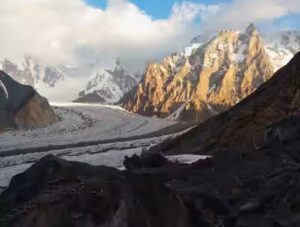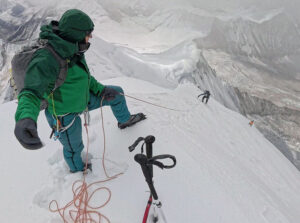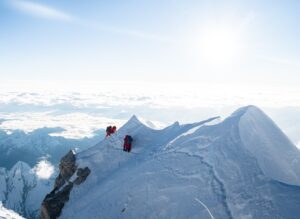Horia Colibasanu is among the last of a fading generation of 8,000m climbers. After 20 years of Himalayan climbing, he still tries to combine a pure style and self-sufficiency on the world’s highest mountains, despite their commercialization.
He has already climbed nine 8,000’ers without supplemental oxygen or personal sherpa support. And he has made some remarkable attempts on new routes, such as Dhaulagiri’s NW Face in 2020 and 2021.
Despite his mountaineering excellence, he makes his living not as a climber, but as a dentist in Timisoara, Romania.
After several seasons in Nepal, Colibasanu has moved this summer to Pakistan’s Broad Peak.
“I intend to complete the 14 8,000’ers, and Broad Peak is the best option because I don’t want to skip the year without an expedition,” he told Explorersweb.
Colibasanu has already summited all the 8,000’ers in Nepal, plus Shishapangma in Tibet. He had no opportunity to go for Cho Oyu this past spring.
No partner
Just before he left for Pakistan, we asked Colibasanu about what he expects from a mountain that lately has suffering from crowding, littered camps and problems from missing ropes and too many inexperienced climbers.
Colibasanu, however, had nothing but positive feelings about his return to the Karakoram. He had only one concern.
“I don’t have a climbing partner,” he said.
After Kangchenjunga last year, his regular partner Peter Hamor of Slovakia decided he had had enough of the 8,000’ers. Instead, this past spring he climbed a new route on a lesser peak, Kabru South.
Colibasanu was hoping to enlist the third member of his former team, Marius Gane, but Gane unexpectedly dropped out a few days ago because of personal issues. Colibasanu admits that his missing friends have left him “a little blue, a little anxious, a little hopeful. But quite fit.”

Left to right, Peter Hamor, Marius Gane, and Horia Colibasanu on Kangchenjunga last year. Photo: Horia Colibasanu
“All the possible inconveniences about Broad Peak fade away over the safety concerns of being alone up there,” Colibasanu admitted. “But I’m staying optimistic. Basically, I want to climb the normal route, and I assume that no 8,000m peak is easy, so I am focusing on safety and enjoying the journey.”
Himalaya are still the place for exploration
Contrary to some heated opinions about the decline of the Himalayan climbing experience, Colibasanu remains enthusiastic.
“The Himalaya and Karakorum are incredible places to be, and two of the last places on Earth for true adventure and exploration,” he said. “I would not like to skydive clinging to an instructor or travel to space or oceans like a cargo bag. Altitude climbing is something very different.
“Also, sometimes fortune smiles on you, and you get a chance to plan different routes, meet excellent partners, or enjoy beautiful weather. That is why I go there; I love these mountains and the beautiful people whom I hope to meet climbing like I do.”

Colibasanu arrives in Skardu airport, a day after leaving his home in Timisoara, Romania. Photo: Horia Colibasanu
Despite his Himalayan experience, Colibasanu has not set foot in the Karakoram since 2004. That summer, he got his first 8,000m experience. His goal was simply to reach 8,000m, but it ended with his first major summit, in style: K2 without supplementary oxygen or porters. This, at a time when K2 was still “The Savage Mountain.”
Memories from K2 in 2004
There, Horia also found a friend for life (even if life is sometimes too short). “I met Inaki Ochoa at Base Camp,” Colibasanu recalls. “His climbing partner at the time [Alex Txikon] switched to the Cesen route, and my team called their attempt off. But the two of us decided to stay and make a last-minute attempt at the summit.”

A very young Horia Colibasanu (left) with Inaki Ochoa de Olza in 2004. Photo: 20 Minutos
They summited on July 28, 2004, and became climbing partners on other Himalayan expeditions. “Finding a friend and climbing a great mountain at the same time is all an alpinist could crave,” Colibasanu said.
Together they attempted to climb Annapurna’s East Ridge in 2008. Then, in Camp 5, Inaki fell sick. What followed was one of the most epic rescue attempts in mountaineering history. But all efforts by some of the best climbers of that era and the constant care of Colibasanu, who stayed by Ochoa’s side for five days, were not enough. Ochoa finally died. Colibasanu and the rest of the rescue team received a special Piolet d’Or “in the spirit of mountaineering” the following year.

An impressive team did their best to help Inaki Ochoa de Olza in 2008. Left to right, Horia Colibasanu, Mihnea Radulescu, Simon Athanamen, Ueli Steck, Alex Gavan, Don Bowie, Inaki’s girlfriend Nancy Morin, Serguey Bogomolov, an unidentified person (the helicopter pilot?), Alexei Bolotov, Robert Szymczak and, crouching, Denis Urubko.
Horia Colibasanu is about to start his trek up the Baltoro toward Broad Peak. In another talk with ExplorersWeb from Skardu, he said he felt great to be back, fit and motivated, and also full of memories from 2004.
At the time he was young, on a shoestring budget, and probably didn’t look so much like a professional climber. He was revved up at having just summited K2. “And then,” Colibasanu recalled, “that Austrian woman abruptly brought me back to earth by asking, ‘Trekking or Expedition?’ ”
The woman was Gerlinde Kaltenbrunner.
Broad Peak ready for summit action

A member of the Furtenbach Adventures team on Broad Peak earlier this week. Photo: Furtenbach Adventures
Colibasanu plans to reach Base Camp by July 5. There, he will find everything ready for the first groups to push for the summit. Furtenbach Adventures has already set up their three camps and fixed the ropes up to the Broad Peak col at 7,800m. The most technical parts of the route, including along Broad Peak’s summit ridge, can be fixed on the go.
Colibasanu, however, will need some time to acclimatize. “Acclimatization must be bistarai (Nepali for slowly). Then the summit push will be fast, strong and determined,” he said.






